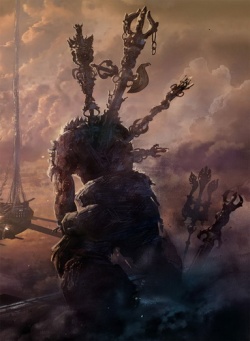Asuras
In Pali Literature the Asuras are classed among the inferior deities together with the
supannas,
gandhabbas,
yakkhas (DA.i.51),
garudas and
nāgas (Mil.117).
asuras are described as titans with a violent and jealous disposition, some of whom however are Buddhist protectors. One of the eight types of celestial beings.
Rebirth as an Asura is considered as one of the four unhappy rebirths or evil states (apāyā), the others being niraya, tiracchānayoni and pettivisaya (E.g., It.93; J.vi.595; J.v.186; Pv.iv.11).
The fight between the Devas and the Asuras is mentioned even in the oldest books of the Tipitaka and is described in identical words in several passages (E.g., D.ii.285; S.i.222; iv.201ff; v.447; M.i.253; A.iv.432; also S.i.216ff).
A chief or king of the Asuras is often referred to as Asurinda (*), several Asuras being credited with the role of leader, most commonly, however, Vepacitti (E.g., S.i.222; iv.201ff; J.i.205) and Rahu (A.ii.17, 53; iii.243).
(*) Sakka was also called Asurinda and Asurādhipa; see, e.g., J.i.66 (Asurindena pavitthadevanagaram viya) and J.v.245, where we are told that from the time he conquered the Asuras he was called Asurādhipa.
Besides these we find Pahārāda (A.iv.197, 200) (v.l. Mahābhadda), Sambara (S.i.227), Verocana (S.i.225; probably another name for Rāhu, see DA.ii.689), Bali (D.ii.259), Sucitti (D.ii.269) and Namucī (D.ii.269).
The Asuras are spoken of as dwelling in the ocean after having been conquered by Vajira-hattha (Indra, elsewhere, [J.v.139] called Asurappamaddana) and are called Vāsava's brethren, of wondrous powers and of great glory. They were present at the preaching of the Mahā Samaya Sutta (see DA.ii.689). Buddhaghosa says that they were all descendants of an Asura maiden named Sujātā. This cannot be the Sujātā, Vepacitti's daughter, whom Sakka married (J.i.205-6). See also Dānavā.
There were evidently several classes of Asuras, and two are mentioned in the Pitakas, the Kālakañjakas and the Dānaveghasas. The Dānaveghasas carried bows in their hands. The Kālakañjakas were of fearsome shape (D.ii.259), and were considered the lowest among the Asuras (D.iii.7; see also Kālañkajaka and Vepacitti).
Once the Asuras dwelt in Tāvatimsa together with the devas. When Magha Mānavaka was born as Sakka, he did not relish the idea of sharing a kingdom with others, and having made the Asuras drunken, he had them hurled by their feet on to the steeps of Sineru. There they tumbled into what came to be known as the Asurabhanava, on the lowest level of Sineru, equal in extent to Tāvatimsa. Here grew the Cittapātalī tree, and when it blossomed the Asuras knew they were no longer in the deva-world.
Wishing to regain their kingdom, they climbed Sineru, "like ants going up a pillar." When the alarm was given, Sakka went out to give battle to them in the ocean, but being worsted in the fight, he fled in his Vejayantaratha. Fearing that his chariot hurt the young Garulas, he had it turned back. The Asuras, thinking that Sakka had obtained reinforcements, turned and fled right into the Asurabhavana. Sakka went back to his city and in that moment of victory, the Vejayantapāsāda sprang up from the ground. To prevent the Asuras from coming back again, Sakka set up as guard in five places Nāgas, Garulas, Kumbhandas, Yakkhas and the Four Great Kings. Everywhere were images of Indra bearing the thunderbolt in his hand. (J.i.202-4; DhA.i.272-80; the same story, differing slightly in details, is found in SnA.484-5). There it is said that when Sakka was born among them, the Asuras received him with great cordiality; see also the various incidents of the Asura war mentioned in the Samyutta Nikāya I. 216ff.
The Asuras are sometimes called Pubbadevā (SnA.484) and their kingdom is 10,000 leagues in extent. SnA.485; elsewhere, in the same page, it is given as 100,000 leagues.
In Buddhaghosa's time, the bygone lustre of the word Asura (as equivalent to Ahura) seems to have faded. His explanation (SA.i.260) of the name is interesting. When Sakka was born with his followers in the Asura-world (which later became Tāvatimsa) the Asuras prepared a drink called gandapāna. Sakka warned his companions not to drink it, but the Asuras became drunk and were thrown down Sineru. Halfway down they regained consciousness and made a vow never to drink intoxicants (surd) again; hence their name Asura.
The Anguttara Commentary (ii.526) defines Asura as bībhaccha, awful, vile. They had a drum called ālambara, made of a crab's claw. They left it behind in their flight from Sakka, and since then Sakka has the use of it (J.ii.344).
A story is told by the Buddha (S.2, v.446) of a man who once saw a whole army with its four divisions enter a lotus stalk and the man thought he was mad. But the Buddha says that it was an Asura army in flight. Here the Asuras would seem to be fairies or nature spirits.


